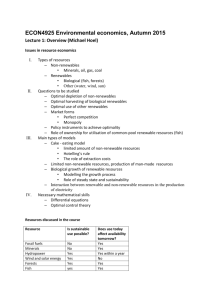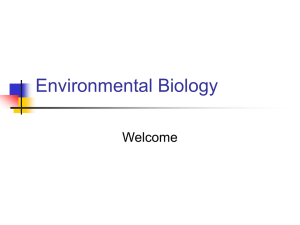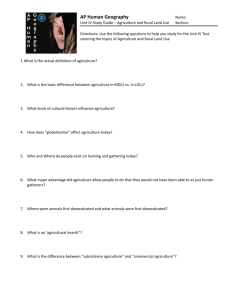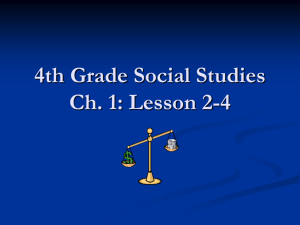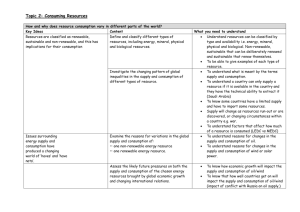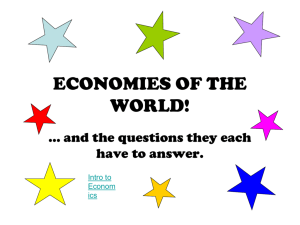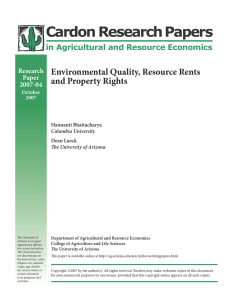types of activities
advertisement
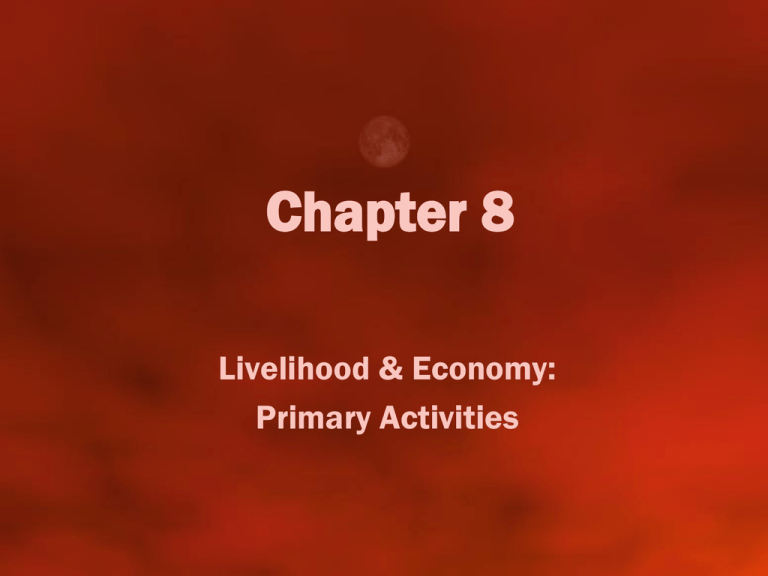
Chapter 8 Livelihood & Economy: Primary Activities Economic geography – Study of how people support themselves, with the spatial patterns of production, distribution, and consumption of goods & services, and with the areal variation of economic activities over the surface of the earth. – To understand we use types of activities & organization to understand patterns Categories of activities • 1. Primary activities – • resource extraction or gathering • 2. Secondary activities – • value added to resources • 3. Tertiary activities – • provide services to primary, secondary sections, general community, to individuals • 4. Quaternary activities – • processing & dissemination of information/administration/control of enterprises • 5. Quinary activities – • high-level decision-making roles in large organization, public/private sphere These five sectors are linked and integrated by transportation & communication. National economies: 3 types • 1. Subsistence • Goods & services created for use of producers & kinship groups • 2. Commercial • Free market, supply & demand • 3. Planned • Goods & services were controlled by government agencies (collapsed, yet landscape & cultural ideologies remain) • All intermix – usually one is dominant • The key variable is transportation Patterns of access & isolation – white indicates areas within 20 miles of railroads, Motor transport, or water navigation. Primary activities • Involves the gathering or extracting natural resources • Hunter & gather groups • Two primary activity groups: – Agriculture – Resource exploitation Subsistence agriculture • Near total self-sufficiency – predominant occupation of mankind today • 2 types: •Extensive •Intensive Extensive subsistence agriculture • Represents a very small % of world population • 2 groups: – Nomadic herding – Shifting cultivation Nomadic herding • Wandering, but controlled movement of livestock • Solely dependent upon natural forage • Dry & cold regions • Requires large expanses of land • Transhumance • Small % worldwide Shifting cultivation • nomadic farming - swidden agriculture, slash & burn • Located in warm, moist, lowlands • Involves about 5% of world’s population • Renewable strategy if: •population is low •non-renewable when population is growing Intensive subsistence agriculture • Involves approximately 50% of the world’s population • Some exchange between subsistence & commercial • Warm, moist climates (primarily in monsoon regions), fertile soils, river valleys, deltas • Large labor requirements, small plots of land, intensive use of fertilizers, often double cropped Intensive farming continued • Urban subsistence farming /garden plots – Increasing phenomenon worldwide – Most prevalent in Asia – Both private and commercial use – Significant food source in cities – Converts waste products to fertilizers, but can spread disease Green revolution – 1950s to 2000 • “high-input, high-yield” concept – Characteristics & requirements: – – – – – Genetically improved seeds Irrigation Mechanization Fertilization Pesticide application – Outcome: – Food production increase, yet growing population – Environmental, cultural, economic impacts Impacts •Irrigation problems •Seed genetics •Displaced traditional farmers •Production gains dropping •Population growth uncontrolled Commercial Agriculture • Characteristics: – 1. Specialization – 2. Off-farm sales (not subsistence farming) – 3. Interdependence of producers & buyers through linked markets – Agribusiness Variables for profit • Uncertainties: – 1. Physical nature of farm land – weather – 2. Costs of production – 3. Uncertainties of growing conditions & total volume output – 4. Supply & demand Solution to uncertainties • Contractual agreements • Uniform product quality, timing of delivery • Guaranteed market & price • Agribusiness, the merging of: •1. Production •2. Processing •3. Marketing von Thünen’s Model – 1783 -1850 •increasing distance from city = low-value crops, extensive land use •near city = high-value crops, intensive land use •can be affected by: topography, soil fertility, changes in market Intensive commercial agr. • High yields, high market value • Highly perishable • Limited field size, repeat plantings Extensive commercial agr • Farther from market, cheaper land • Large land size required • Dry farming / livestock ranching • Low labor requirements • Marginal land quality Livestock ranching & special crop agriculture Principal wheat-growing areas of the world Resources – primary activity • Two classifications: – Gathering industries •Harvesting of renewable resources – Extractive industries •Removal of non-renewable minerals Natural resources • Naturally occurring materials that humans view as necessary/useful for its economic/material well-being – Renewable •maximum sustainable yield – Non-renewable • Humans have a changing view of resources Fishing • Primary, renewable resource • 75% of world catch = human consumption • 1 billion people rely upon this resource • 25% = processed fish meal for livestock/fertilizers • One of the most dangerous industries – U.S.: 86 deaths per 100,000 Fish supplies • 120 million tons harvested worldwide • Maximum sustainable yield is exceeded • Sources: – 1. Inland catch – 2. Fish farming – 3. Marine catch Overfishing & problems • Collapse of certain species • Problems: – 1. Effect of El Nino – 2. Pollution of inland & coastal waters – 3. Destruction of mangrove forests, coastal wetlands, estuaries, shallow continental shelf areas Tragedy of the Commons • Accepted view that world’s oceans are common property – open to all • No one is responsible for its maintenance, protection, improvement – no collective controls • Each user - exploits resource to maximum – otherwise someone else will do so Results • 1982 – United Nations Convention on the “Law of the Sea” treaty •Gave control of 200 nautical miles to nearest country • Increasing fish farming •Aquaculture – both marine & freshwater Forestry • Primary, renewable resource • 12,000 years ago forest covered 45% of earth • Today = 30% • Two large global belts of commercial forests: – Upper-middle latitudes of the Northern Hemisphere – Equatorial zones of South & Central America, Central Africa, Southeast Asia • One of the most dangerous industries – U.S.: 92 deaths per 100,000, highest danger rate Major commercial forest regions Mid-latitude forests • Largest, most continuous stand, extending around the globe – Boreal, temperate, 40°N to 70°N • Northern region of forest – Coniferous, softwoods • Pine, spruce, fir – Largest, most continuous stand, low diversity – Construction uses, lumber, pulp • Southern region of forest – Deciduous hardwoods • Oak, maple, hickory, birch – Greatly reduced Condition today • Both regions threatened by: – Acid rain, atmospheric pollution, over harvesting, invasive species • Areas held constant through: – Conservation, preservation/protection, reforestation Tropical lowland forests • South & Central America, Central Africa, Southeast Asia – Mahogany, teak – Biodiversity, heavy forests can restrict ease of extraction – Primarily located in the developing world • Primarily exploited for: – Fuel, charcoal, and increasingly for lumber Problems & threats • Northern forests: – 45% is for industrial use • Southern forests: – 55% is for fuelwood/charcoal use • Forest depletion = – Loss of a renewable resource – Conversion to agricultural lands – marginalized – Economic/ecological implications Fur trapping & trade • Ancient practice, dependent on northern forests • 1960s – anti-fur campaigns began & continue • Farmed furs = today, 85% of industry – Northern forest belt – Increasingly challenged for inhumane treatment of animals – Public banning of fur products Mining & quarrying • Primary, non-renewable resources – Distribution is uneven, determined by past geologic events • Extraction is possible with technology – First –most accessible, highest quality – Second – lower-grade quality ore • Requires higher energy consumption for extraction – Deeper in earth – Lower grade – Smaller deposits Mineral resources • Non-renewable resource – 1. Proven resources – 2. Known reserves – 3. Potential reserves • Mining & mineral extraction: one of the three top most dangerous industries Metallic minerals • Copper, lead, iron ore • Most abundant locations: – Russia, Canada, China, United States, Brazil, Australia • Production is balanced by: • 1. Quantity available • 2. Richness of ore • 3. Distance to markets • Dynamic market results in varying interests in deposits Non-metallic minerals • Common: sand/gravel, gypsum, limestone, building stone • Two types of usage: – Construction use (ingredients for cement) •Widest distribution, greatest use, least longdistance movement – Fertilizer use (potash, phosphate) •Unequal distribution •International trade higher market value Mineral fuels • Fossil fuels: coal, petroleum, natural gas – Made industrial revolution possible – Non-renewable Coal • Coal: earliest usage, most plentiful – Largest reserves • United States, China, Northern Hemisphere – open-pit (surface mining) • Very damaging to environment – cutting off of entire hilltops • relatively cheap extraction costs – shaft mining • expensive, more dangerous – Very polluting – slag heaps, ecosystem destruction – Bulky to move Petroleum • 75% of proven reserves in just 7 countries • Usage boomed in 20th century • Costs & effects: •Cheaper & easier to move than coal •Polluting – global warming •Reserves are diminishing •Due to distribution & lack of availability – market value fluctuations, politically sensitive Natural gas • 25% of global energy consumption • Popular due to: – Highly efficient, versatile – Requires little processing – Environmentally safe • Problems: – Uneven distribution – Difficult to move • Pipeline, good, but transoceanic, difficult at best – Limited supply
